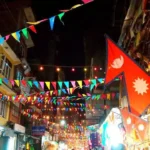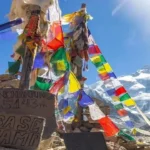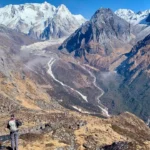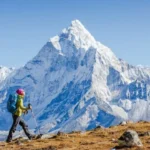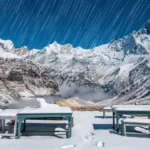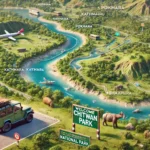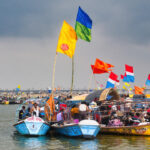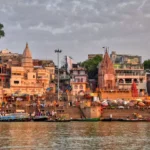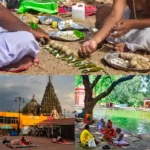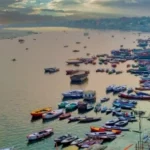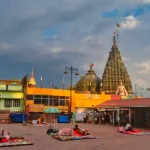Things to Do Around Rara Lake
Rara isn’t just a place you look at—it’s a place you experience. Once you’ve made the journey to Nepal’s largest lake, you’ll find a peaceful yet activity-filled escape waiting for you. Whether you’re into hiking, relaxing, or immersing in local life, there’s plenty to do.
🛶 1. Boating on Rara Lake
Hop into a wooden boat and glide across the mirror-like surface of Rara. It’s calm, quiet, and surreal—especially in the early morning or golden hour. You’ll get unbeatable views of the forested shores and snow-dusted peaks reflecting on the water.
Don’t forget your camera—sunrise and sunset here are next-level dreamy.
🥾 2. Hiking and Trekking
There are plenty of short hikes and multi-day treks that loop around or lead to Rara Lake. You can do:
🐾 3. Wildlife Spotting
Keep your eyes peeled—you’re in the heart of Rara National Park, after all! You might spot:
- Red pandas (if you’re lucky!)
- Himalayan black bears
- Musk deer
- Monals and other colourful Himalayan birds
Birdwatchers, bring those binoculars—this place is a feathered paradise.
📸 4. Photography & Nature Observation
Rara is a photographer’s dream. The lake shifts colours depending on the time of day, and the surrounding mountains offer dramatic backdrops for your shots. From wide-angle landscapes to macro shots of wildflowers, every angle here is Instagram-worthy.
🏕️ 5. Camping by the Lake
If you’re into sleeping under the stars, Rara is a top-tier camping spot. Some trekkers choose to pitch tents near the lakeside, waking up to the sound of birdsong and views that feel too perfect to be real.
Pro tip: Make sure to follow Leave No Trace principles—Rara’s beauty depends on responsible tourism.
🏘️ 6. Explore Local Villages and Culture
Visit Murma Village or other small settlements near the lake to meet the Thakuri and other indigenous communities. You’ll learn about local customs, try traditional food, and get a glimpse of what life is like in one of the most remote parts of Nepal.
🧘♀️ 7. Just… Chill
Sometimes, the best activity is no activity at all. Read a book by the shore, journal, meditate, or simply breathe it all in. At Rara, nature does the entertaining.
So whether you’re here to hike, connect with local culture, or just escape the noise of daily life, Rara Lake offers experiences that refresh both body and soul.

Where to Stay Near Rara Lake
While Rara Lake is wild and remote, you don’t have to rough it completely—unless you want to! There are a handful of accommodation options that let you stay close to nature without sacrificing comfort, ranging from basic guesthouses cosy homestays and lakeside camping.
🛏️ 1. Teahouses & Guesthouses (Basic but Comfortable)
The most common type of accommodation near Rara Lake is simple teahouses and local guesthouses, especially around:
- Talcha Airport
- Murma Village
- Jhyari Village
These places are no-frills but welcoming, usually offering a bed, warm blanket, dal bhat (local rice and lentils), and hot tea. Expect squat toilets, solar-powered lights, and very limited Wi-Fi (if any).
Tip: Bring a sleeping bag for extra warmth, especially in colder months.
🏕️ 2. Camping – For the Adventurous Soul
If you want the full immersion experience, camping by Rara Lake is unforgettable. You’ll wake up to mist rising off the water, with birds chirping all around.
- You can bring your gear, or
- Join a guided trek that provides tents, meals, and porters.
Just make sure to camp in designated areas and pack out all your trash—this is a fragile ecosystem.
🏠 3. Homestays – Cultural Immersion
Some local families in nearby villages offer homestay experiences, giving you a chance to:
- Stay in a traditional mud-and-stone home
- Eat local food prepared by your host.
- Learn about the Thakuri or Tibetan-influenced cultures of the region.
Homestays are a great way to support local communities while gaining deeper insight into the way of life here.
📍 Where Most Travelers Stay
| Area |
Type of Stay |
Good For |
| Murma Village |
Guesthouse, homestay |
Close to viewpoints & culture |
| Near Talcha Airport |
Lodge, basic hotel |
Convenience after flights |
| Lakeside (camping) |
Tent setup |
Full nature immersion |
What to Expect:
- Electricity: Limited; mostly solar
- Wi-Fi & Mobile Network: Spotty at best—enjoy the digital detox!
- Hot Showers: Rare, and usually solar-heated
- Booking: Most places don’t take online bookings—just show up or go with a guide
So, while you won’t find luxury resorts here (yet), the accommodations around Rara Lake offer something even better: peace, authenticity, and a true connection to nature.

Local Culture and People of Rara Lake
Beyond the jaw-dropping scenery, one of the most enriching aspects of visiting Rara Lake is connecting with the local communities who live in this remote Himalayan region. Here, life moves to a slower rhythm, shaped by centuries-old traditions, deep respect for nature, and a strong sense of community.
👥 Who Lives Near Rara?
Most of the people living in villages near Rara Lake—such as Murma, Jhyari, and Majhghat—belong to the Thakuri, Chhetri, and Tibetan-influenced ethnic groups. These communities are primarily agricultural and pastoral, living in harmony with the surrounding forests and mountains.
Their homes are built from local stone and mud, and daily life revolves around farming, herding, weaving, and prayer.
🙏 Culture Rooted in Nature and Faith
Spirituality plays a major role in local culture. Many families follow a blend of Hindu and Tibetan Buddhist traditions, with small shrines and prayer flags dotting the landscape.
You may hear stories of the lake being sacred, protected by local deities, and treated with the utmost reverence. Locals often consider Rara a “gift of the gods”, and they take great pride in preserving its natural purity.
Visitors are encouraged to show respect by dressing modestly and asking before taking photos of people or religious sites.
🍛 Local Food & Hospitality
Expect warm hospitality if you stay in a homestay or interact with villagers. Meals are simple but hearty—typically dal bhat (rice and lentils), tarkari (vegetable curry), homemade pickles, and fresh yoghurt or milk straight from the source.
Don’t be surprised if you’re offered chang (fermented millet drink) or butter tea, especially during festivals or as a sign of welcome.
🎉 Festivals and Traditions
If you visit during a local festival, consider yourself lucky. Celebrations are intimate but vibrant, with traditional music, dancing, and rituals.
Some festivals you might witness:
- Dashain and Tihar – major Hindu festivals celebrated with local twists
- Yartung Festival (in nearby Mustang, sometimes echoed here) – involves horse racing and feasting.
- Local harvest ceremonies, where villagers give thanks to the land and gods
🤝 A Word on Responsible Travel
Many of the villages near Rara Lake are underserved by modern infrastructure, so your presence as a traveler has real impact. Consider supporting locally-run lodges, buying handmade crafts, and traveling respectfully—your positive footprint goes a long way.
Rara Lake isn’t just a natural treasure—it’s also a window into a rich and resilient way of life. Taking time to learn from the people who call this remote region home adds a layer of meaning to your journey that goes far beyond the postcard-perfect views.
Conservation Efforts and Environmental Importance of Rara Lake
Rara Lake isn’t just a stunning destination—it’s an ecological treasure that plays a vital role in the region’s environment, biodiversity, and water systems. Its remote location has helped keep it pristine, but increasing interest from travellers also means increased responsibility. Fortunately, efforts are in place to preserve this Himalayan gem for future generations.
🧭 Protected Under Rara National Park
Rara Lake lies at the heart of Rara National Park, which was established in 1976 to protect the region’s unique flora, fauna, and alpine ecosystems. The park enforces strict rules against logging, poaching, and unregulated construction. It’s overseen by Nepal’s Department of National Parks and Wildlife Conservation (DNPWC), which manages both ecological research and visitor impact.
All visitors are required to obtain a national park entry permit, helping fund conservation efforts.
🐟 A Ramsar-Listed Wetland
In 2007, Rara Lake was designated as a Ramsar Site, officially recognizing it as a wetland of international importance. This status highlights its role as a crucial habitat for:
- Endemic aquatic species like the Rara snow trout (Schizothorax paraenesis)
- Migratory and resident birds
- Unique high-altitude plant species
Wetlands like Rara help regulate climate, store fresh water, and serve as biodiversity hotspots—making their protection a global priority.
🌱 Community Involvement and Sustainable Tourism
Local communities are increasingly involved in protecting the lake and surrounding parks. Initiatives include:
- Eco-tourism training for local guides and homestay owners
- Trash cleanup programs and designated camping areas
- Sustainable farming practices are encouraged through government and NGO support.
These efforts not only help the environment but also ensure that tourism benefits locals directly, creating a win-win for both people and the planet.
♻️ What You Can Do as a Visitor
Being a responsible traveller goes a long way in a place like Rara. Here’s how you can help:
- Carry out all trash—there are limited waste facilities in the park
- Use refillable water bottles to reduce plastic waste.
- Stay on marked trails to avoid disturbing fragile plant life.
- Choose eco-conscious accommodations that support local communities.s
Remember: the best souvenir is a story, not a footprint.
Rara Lake stands as a model of how natural beauty, cultural heritage, and conservation can coexist— but it depends on ongoing care and mindful tourism. Every visitor plays a role in keeping this Himalayan sanctuary wild, clean, and alive.

Travel Tips and FAQs for Visiting Rara Lake
Planning a trip to Rara Lake? Here’s your go-to guide with essential travel tips and answers to the most common questions, so you can focus more on the views and less on the logistics.
✍️ Do I Need a Permit to Visit Rara Lake?
Yes! To enter Rara National Park, you’ll need:
- A National Park Entry Permit (can be obtained in Kathmandu or at park entry points)
- A TIMS card (Trekkers’ Information Management System) if you’re trekking independently
Pro tip: If you’re going with a guide or agency, they’ll usually handle this for you.
🛫 What’s the Best Way to Get There?
The most efficient route is:
- Fly Kathmandu → Nepalgunj
- Fly Nepalgunj → Talcha Airport
- Trek ~3 hours to Rara Lake
Alternatively, you can trek in overland via Jumla, but it takes several days.
🧥 What Should I Pack?
Pack smart for changing weather and basic conditions. Essentials include:
- Warm layers (especially for nights)
- Rain gear (even in spring/fall, just in case)
- Sleeping bag
- Water purification tablets or filter
- Headlamp/torch
- Snacks and energy bars
- Power bank (electricity is limited)
- First aid kit
Bonus: Bring some books or a journal—Rara is perfect for unplugging and reflecting.
📶 Is There Wi-Fi or a Mobile Network?
Don’t count on it. Mobile coverage is spotty to nonexistent, and Wi-Fi is rare. Embrace the digital detox—it’s part of the charm.
💰 How Much Cash Should I Bring?
There are no ATMs near Rara, so bring enough Nepali rupees in small denominations for your entire trip—lodging, food, snacks, tips, etc.
🧼 What Are the Bathroom and Shower Situations?
Most guesthouses and homestays have basic squat toilets and bucket or solar showers. Keep expectations low and bring:
- Toilet paper
- Hand sanitiser
- Biodegradable soap
🐾 Is It Safe to Visit Rara Lake?
Yes, it’s generally very safe. The local people are friendly and helpful. Just be prepared for:
- Altitude adjustment
- Basic healthcare access
- Remote conditions
Travel insurance is highly recommended, especially if flying or trekking in.
🕒 How Long Should I Stay?
Most visitors spend 2–3 nights at or around the lake, but longer treks (like Jumla–Rara or Dolpo–Rara) can turn your visit into a week-long or even 2-week Himalayan journey.
✅ Final Tips
- Travel with a guide if you’re new to trekking or off-grid travel
- Be respectful of local customs and dress modestly.
- Don’t rush—Rara’s magic unfolds slowly
Rara Lake is more than just a destination—it’s an experience that leaves you feeling deeply connected to nature and culture. A bit of preparation goes a long way in making your trip smooth, safe, and unforgettable.










